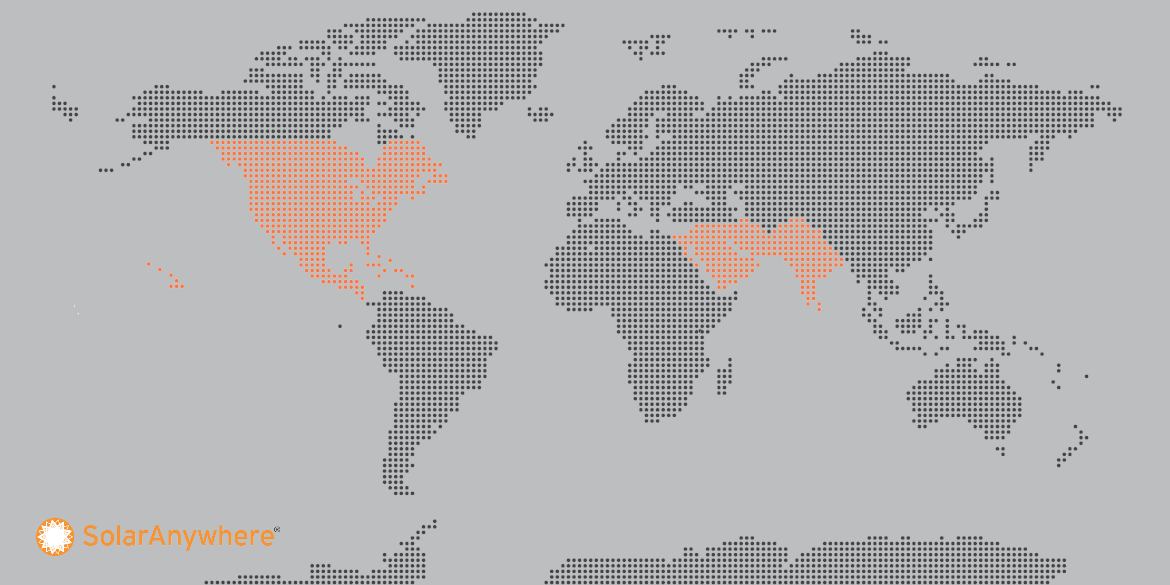Thanks to our subscribers, partners and hard-working development team, SolarAnywhere® has become the most trusted and vetted solar resource dataset available. In 2017 alone, the SolarAnywhere team:
- Topped an EPRI study for forecasting
- Spotted a calibration issue at one of the nation’s most trusted reference stations
- Released real-time V3.2 time-series data in conjunction with the switchover to GOES-16
- Spun-up a new satellite to offer data in India and the Middle East
This was all in addition to facilitating gigawatts of new solar development and management of existing PV fleets. This increased adoption gave us an opportunity to ask how our customers are using SolarAnywhere. Looking forward to 2018-19, we’re planning for significant geographic, temporal and spatial capability expansion, along with more features that give SolarAnywhere users faster access to on-demand data and site-specific analytics and intelligence.
To better address our users’ feedback and needs, starting today, we’re releasing new SolarAnywhere license options.
Typical Year licenses: a 1-region world
Until now, Clean Power Research has offered unlimited-use TGY licenses by region, e.g. the U.S. or Canada. We now offer three tiers of access to our most current SolarAnywhere data model to suit every budget, with paid licenses covering any location we offer coverage (currently North America, India and the Middle East).
- Professional: Fully supported and bankable, our V3.2 dataset is now available at a more accessible price point. Pro licenses cover 25 sites per year, ideal for regional developers. What’s more, access is available anywhere we have data coverage.
- Unlimited Web and Unlimited API: Does your company speak in gigawatts? Good news! We still offer unlimited licenses, and your license covers an ever-expanding geographic region. API and web access are available. This option offers the best value for getting projects to financing.
Historical Time Series licenses: the 1 km standard
Since we started offering 1 km resolution data seven years ago, we’ve seen demand for enhanced resolution data steadily increase. As a result, we’re now offering 1 km data as the standard for SolarAnywhere historical time series licenses.
We often get asked when it’s appropriate to use 1 km (Enhanced) vs. 10 km (Standard) data. To answer that question, it helps to start with some detail on how 10 km data is created. The primary satellites we use in our satellite-to-solar algorithm have a native visible-light resolution of 1 km. We generate 10 km data by sampling 1 km data at 10 km intervals. Our validation against high-quality ground measurement stations demonstrates that 10 km data is highly accurate across the SolarAnywhere coverage area and supports key use cases like prospecting and P50 analysis.
In complex terrain or coastal areas however, the enhanced spatial resolution makes all the difference. In Hawaii, for example, we’ve seen >10% difference in irradiance in just a few kilometers. A 1 km tile co-located with your exact project location ensures the data is most representative of the available solar resource.
What’s more, we see an overall reduction in uncertainty in 1 km versus 10 km data. The most common use case for our historical time series data is as an input to bankable resource assessments for commercial and utility scale PV project financing. In these cases, reducing resource risk significantly improves project returns, so it makes sense to make 1 km data the time-series standard.
We’re confident the change will reduce confusion and benefit users. At the same time, we’ve reduced pricing on 1 km data to help 10 km customers transition to the new licensing options. Annual data licenses are priced per-site, with each site giving access to a 3 x 3 grid of 1 km tiles to cover larger projects and assess spatial variability in the resource. Volume discounts are available for organizations purchasing at least 10 or 50 sites annually.
Academic license: supporting research
Clean Power Research remains committed to supporting renewable energy research and offers irradiance data in the U.S. free of charge with an Academic license. The Academic license provides limited access to V2.X SolarAnywhere Data, which grew out of the work with NREL on the National Solar Resource Database (NSRDB) dataset. Both Typical Year and Time Series data are available. Commercial use of data obtained through an Academic license is not supported.
What’s next?
The license options above cover a few of the most common use-cases. API pricing is still on a case-by-case basis. Please contact us with special requests or nascent use-cases. We’re always evolving to meet the dynamic needs of the energy industry.
Ready to get started? See all SolarAnywhere Typical Year and Time Series pricing options available, including no-cost academic licenses.
